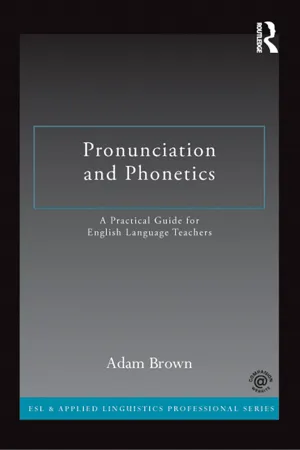![]()
Section 1
Phonetics
![]()
1 Introduction
If you can speak, you can do anything.
Sir Winston Churchill (1874–1965), British prime minister
Learning objectives
At the end of this chapter, you will be able to
• define the terms phonetics, phonology, pronunciation and phonics
• list the segmental and suprasegmental features of English pronunciation
• draw a hierarchy of functional units of pronunciation.
Introduction
The purpose of this book is to equip readers with what they need in order to teach the pronunciation of English. As pronunciation is one of the skills involved in learning any language, some of this overlaps with what is covered in general courses for English language trainee teachers. However, pronunciation is often poorly covered in such courses.
The coverage in this book is very selective. That is, only those aspects of the technical side of phonetics that have strong implications for English pronunciation teaching are handled. Many other aspects have deliberately been omitted, but can be found in general books on English phonetics (see the Resources section).
First, however, we need to define four terms relating to the whole field: phonetics, phonology, pronunciation and phonics.
Phonetics
In a sentence, phonetics can be defined as the scientific study of all aspects of the spoken form of language. There are several important terms in this definition:
• Scientific: Phonetics is scientific in the sense that it is objective rather than subjective. That is, phoneticians describe the sounds of languages in an unbiased, dispassionate way. In contrast, many lay people speak in a prejudiced way about the sounds of their language. Very often, this takes the form of preferring aspects of their own pronunciation over those of anyone else’s accent, and trying to impose their own thoughts on others. Thus, they tell people how they think a language ought to be pronounced, rather than describing how it actually is pronounced. Such people are prescriptive, while phonetics is a descriptive subject.
• Language: Notice that language is used here, rather than a language. By language, we mean the human ability to communicate, that underlies all human languages. Although much of phonetics has historically been concerned with English, the study of the sounds of an ‘exotic’ language spoken by only a few speakers is no less valid.
• Spoken form: Language, the human ability to communicate, may be manifested in different ways (or mediums). By far the most common are the spoken medium and the written medium. Others exist, such as Braille, a tactile medium. Both the spoken and written mediums have a productive and perceptive form. This gives us the categories of writing, reading, speaking and listening, often referred to by language teachers as the four skills (see Table 1.1).
Table 1.1 The four language skills
| Written medium | Spoken medium |
Production | Writing | Speaking |
Perception | Reading | Listening |
• All aspects: When we speak to someone, there are three distinguishable phases of the communication process:
1 The speaker uses his/her vocal organs (lungs, vocal cords, tongue, lips, etc.) to produce sounds. This aspect is known as articulatory phonetics.
2 The sounds are vibrations of air particles (sound waves), that travel from the speaker’s mouth to the listener’s ear. The technical study of these vibrations is known as acoustic phonetics.
3 The sound waves reach the listener’s ear, travel along his/her ear canal and cause the ear drum to vibrate. This movement is transmitted to the brain and ultimately interpreted. This aspect is known as auditory phonetics.
While all three aspects belong to the field of phonetics, only the first (articulation) is of real relevance in language teaching.
Phonology
Articulatory phonetics thus describes the way humans use their vocal organs to produce speech sounds. Phonology, on the other hand, describes the way these sounds function in particular languages. For instance, we can describe two sounds as follows:
• For the [ph] sound, the two lips come together blocking air from escaping through the mouth. Air does not escape through the nose either. The vocal cords are not vibrating. When the lips are opened again at the end of the sound, there is a burst of air (known as aspiration) before the vocal cords start vibrating for the vowel sound that usually follows.
• The same thing happens for the [p=] sound, except that, when the lips are opened, the vocal cords start vibrating immediately for the following sound (usually a vowel). While [p=] is not an official symbol of the International Phonetic Association (IPA), it is a useful way of explicitly showing lack of aspiration, and is used by writers such as Wells and Colson (1971).
Notice that there is no mention of any particular language in the above descriptions. We are simply saying that if you make those movements with your vocal organs, we can use that symbol to repres...
